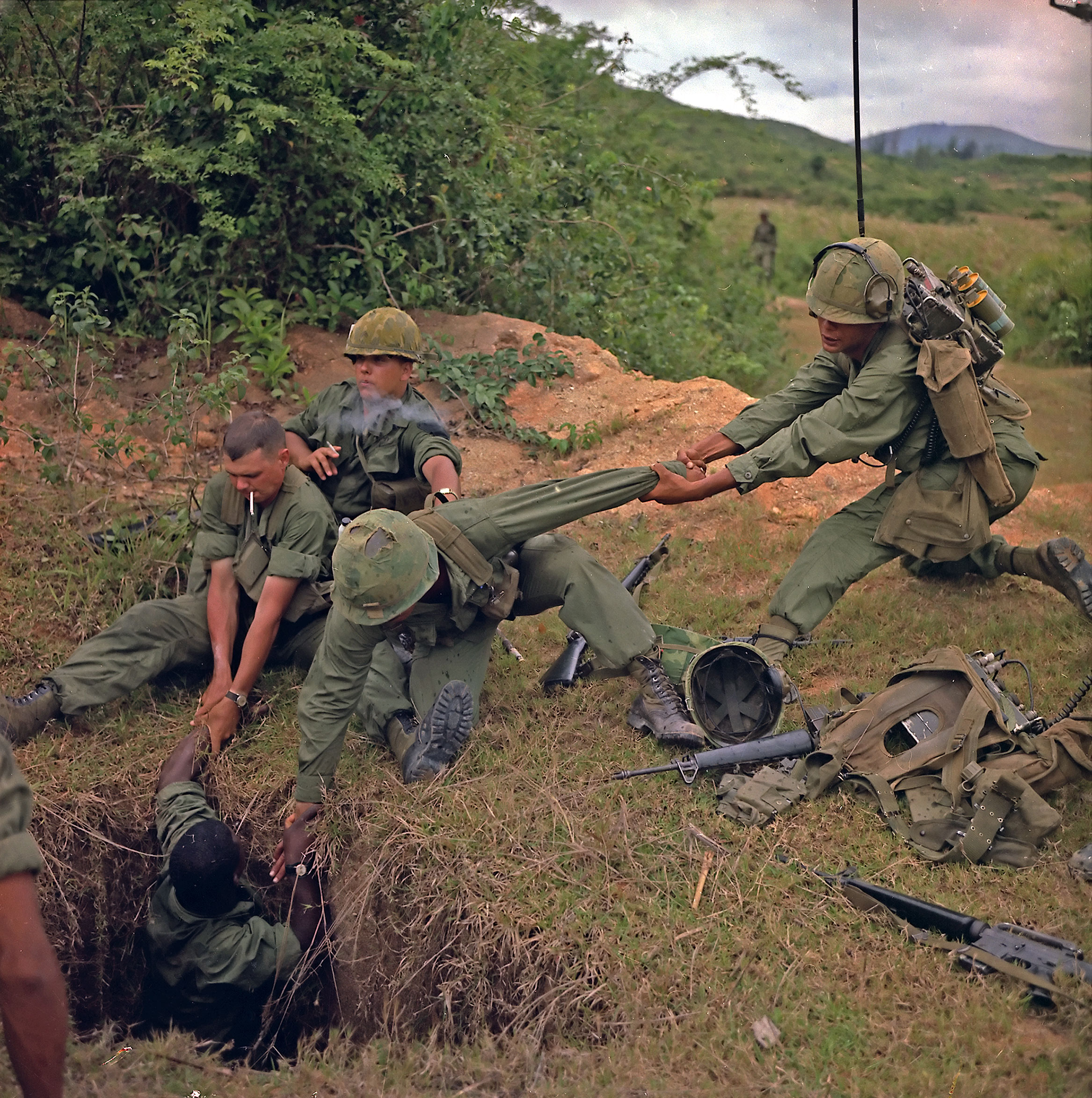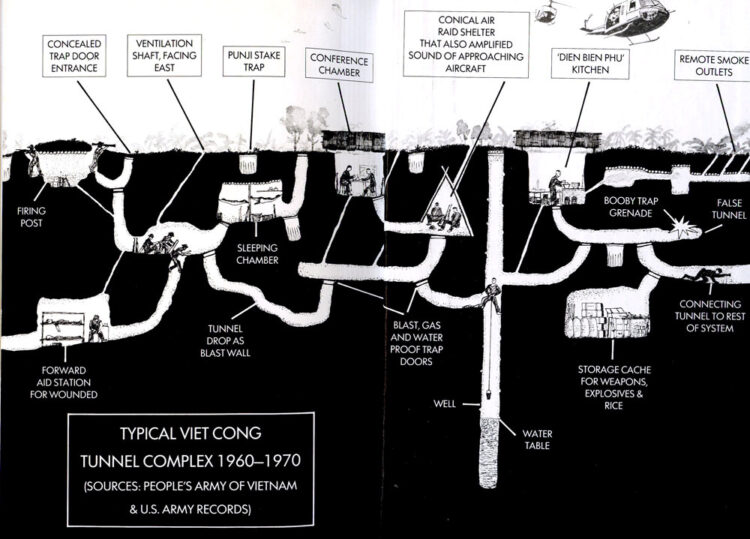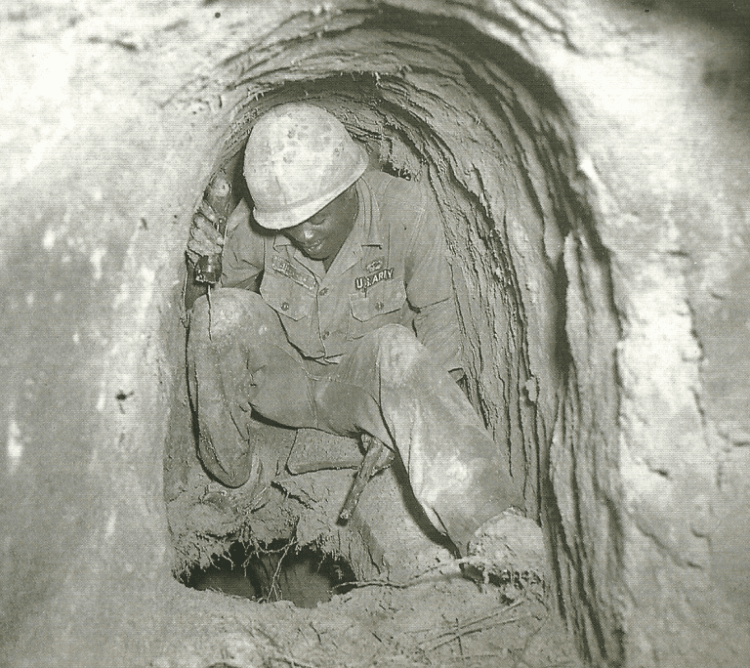During the Vietnam War, one of the most perilous and harrowing roles a soldier could undertake was that of a ‘Tunnel Rat.’ These brave individuals were tasked with infiltrating the complex network of underground tunnels used by the Viet Cong and North Vietnamese forces. Tunnel Rats were originally called “Tunnel Runners” by the 25th Infantry Division, and “Ferrets” by the Australian Army. The term “Tunnel Rat” soon became their official accepted name. A chemical officer of the 1st Inf Div, Capt Herbert Thornton, was charged with setting up the first tunnel team in 1966. Thornton sought men for his tunnel team had an even temperament, an inquisitive mind, and had to be exceptionally brave. Also, they had to be able to squeeze through tight trap doors and crawl along the narrow passages with relative ease. The cramped and claustrophobic tunnels of Vietnam were often just wide enough for a single person to crawl through. Most ‘Rats’ were short, and less than 5 feet 5 inches tall and with a slight, wiry build.
Tunnel systems in Vietnam have a history that predates the Vietnam War. The idea of using underground passages for military purposes was not new to the region. During earlier conflicts, such as the resistance against French colonial rule, Vietnamese fighters utilized tunnel networks for guerrilla warfare and as hideouts. The communists began digging these tunnels in the late 1940s during their war against the Japanese, and also the French in the early 1950s. In the early 1960s, the next generation of communist guerrillas (this time the Viet Cong) improved these tunnels, eventually expanding. These tunnels were a wonder of what they housed, such as:
- underground storehouses
- barracks
- manufacturing facilities
- ammo dumps
- kitchens
- air raid shelters
- hospitals
- store rooms
- workshops
- latrines
- command centers
- even theatres for the performances of political plays.
A diagram of a basic Viet Cong tunnel system. U.S. Army
The Viet Cong were determined tunnellers, and it proved to be their best defense against American firepower and air superiority. The tunnels in Vietnam were ingeniously designed with multiple levels, hidden entrances, and concealed traps to deter and confuse invaders. The narrow passageways were deliberately built to limit the effectiveness of larger, better-equipped forces. Tunnel construction was an arduous task, with guerrilla fighters using basic tools like shovels, picks, and bamboo baskets. The tunnels were often dug by hand, and the soil was removed and dispersed into nearby fields to avoid detection. Tunnel Rats faced a myriad of dangers, including booby traps, tripwires connected to grenades, hidden openings, and punji stick traps. The limited visibility made it nearly impossible to detect danger before it was too late, placing these soldiers in an incredibly vulnerable position.
The tunnel systems (where the water table permitted) had several levels, each level was separated by a watertight trap door which would seal the rest of the system against gas, flooding, etc. The trap doors themselves were virtually undetectable and could fool a person into believing that the tunnel finished in a dead end, when in reality it led into a huge system of other passages. Passages were made with corners that had between a 60 – degree and a 120 – degree angle to them. The tunnels were not cut in dead straight lines, so this made shooting in a straight line impossible. Occupants would be protected from the deflected explosive blasts from grenades that might be thrown down by Western soldiers. Attempts to “smoke out” Viet Cong with tear gas or smoke grenades failed in the larger networks. All the tunnel systems had drain pipe sized ventilation shafts leading from the surface down to the 1st level. These vents were constructed with, “an oblique angle so as to prevent the monsoon rains flooding the system. Vents were placed so as to face east and the light of a new day, whilst others were placed toward the wind so as to provide a constant cooling draught. Despite these efforts the tunnels were still hot, dark, and claustrophobic, even at the best of times.”
The tense atmosphere and constant fear of the unknown made the role of a Tunnel Rat not just physically demanding, but mentally and emotionally draining as well. The psychological toll on Tunnel Rats cannot be overstated. The constant stress of navigating the perilous tunnels, combined with the isolation and ever-present threat of death, took a heavy toll on the mental well-being of these soldiers. Many experienced heightened levels of anxiety, fear, and even post-traumatic stress disorder (PTSD) as a result of their harrowing experiences underground. As Tunnel Rats moved cautiously through the tunnels, they never knew what awaited them around the next bend.
“There weren’t many tunnels up North at Khe Sanh however in Danang and south there were many. One tunnel complex was under the PX at Marble Mountain by DaNang base. They had a hospital and barracks for the Viet Cong. They also had many spider holes everywhere. Just big enough for one man with a grass cover to hide and cause havoc and set up ambushes.” Vietnam Veteran Jim Wodecki
The most iconic and extensive tunnel network used for war during the Vietnam War was the Cu Chi Tunnels, located near Saigon (now Ho Chi Minh City). These tunnels, initially built during the French occupation, were expanded and refined by the Viet Cong and North Vietnamese forces during the Vietnam War. The Cu Chi Tunnels consisted of an intricate system of underground passages that included living quarters, storage areas, kitchens, hospitals, and command centers. They stretched for over 120 miles and played a crucial role in the Viet Cong’s strategy of resistance against American and South Vietnamese forces. The tunnels provided the Viet Cong with a safe haven, allowing them to launch surprise attacks, ambushes, and hit-and-run operations. The tunnel network also facilitated the movement of troops and supplies, providing a strategic advantage in a conflict characterized by asymmetrical warfare.
A tunnel rat explores a hole between “floors” of the tunnel system. These changes in elevation were among the most dangerous situations for tunnel rats because they could not ensure no traps or enemy were present before going through. U.S. Army
To counter the tunnel threat, the U.S. military employed various tactics, including ground-penetrating radar, specially trained dogs, and explosive ordnance disposal teams to detect and destroy tunnels. Despite these efforts, the complex tunnel systems remained a formidable obstacle. The presence of tunnels posed a significant challenge to American and South Vietnamese forces.
Tunnel Rats underwent rigorous training to prepare for the challenges they would face in the tunnels. This training included learning how to navigate the tight spaces, detect traps and booby traps, and engage in close-quarters combat. They were equipped with specialized gear, such as small arms, flashlights, combat knives, and explosives for clearing obstacles and traps. Entering a tunnel required extreme caution. Tunnel Rats often moved in pairs or small teams to minimize the risks. They would crawl or inch their way through the narrow tunnels, using flashlights to illuminate the darkness. Careful foot placement was crucial to avoid triggering traps. Soldiers learned what worked best in their area and with their techniques and stuck with them.
Engaging the enemy in the tunnels demanded quick reflexes and close-quarters combat skills. Tunnel Rats would encounter enemy fighters in confined spaces, necessitating hand-to-hand combat or using firearms at point-blank range. The advantage often went to the soldier who remained calm under pressure. The presence of Tunnel Rats instilled fear and uncertainty among the enemy. The Viet Cong and North Vietnamese forces knew that their tunnels were not safe havens, and the constant threat of Tunnel Rats kept them on edge.
Here are a few notable books about the Tunnel Rats.
- “The Tunnels of Cu Chi” by Tom Mangold and John Penycate: This book provides an in-depth exploration of the tunnel systems used by the Viet Cong during the Vietnam War and the efforts of the Tunnel Rats to combat this underground threat.
- “Tunnel Rats vs the Taliban: How Aussie Sappers in Afghanistan Took on the Taliban” by Jimmy Thomson and Sandy MacGregor: While not exclusively about the Vietnam War, this book draws parallels between modern-day tunnel-clearing operations in Afghanistan and the experiences of Tunnel Rats during the Vietnam War.
- “Tunnel Rat in Vietnam” by Gordon L. Rottman: This book offers a firsthand account of the author’s experiences as a Tunnel Rat during the Vietnam War, providing a personal perspective on the challenges and dangers of this role.
- “Under Fire: An American Story” by W.E.B. Griffin: While not solely focused on tunnel rats, this novel is part of a series that explores the lives and experiences of American soldiers during the Vietnam War, including segments that touch on tunnel exploration.
- “Where the Ashes Are: The Odyssey of a Vietnamese Family” by Qui Duc Nguyen: This book tells the story of the Nguyen family’s experiences in Vietnam, including sections that discuss the use of tunnels during the war and the experiences of those who navigated them.
- “Steel My Soldiers’ Hearts: The Hopeless to Hardcore Transformation of U.S. Army, 4th Battalion, 39th Infantry, Vietnam” by David H. Hackworth: This memoir provides insights into the experiences of soldiers during the Vietnam War, including descriptions of tunnel exploration and combat.
*The views and opinions expressed on this website are solely those of the original authors and contributors. These views and opinions do not necessarily represent those of Spotter Up Magazine, the administrative staff, and/or any/all contributors to this site.
SOURCE
https://www.warhistoryonline.com/instant-articles/the-tunnel-rats-vietnam-war.html
https://www.thenmusa.org/articles/tunnel-rats-of-the-vietnam-war/
https://www.history.com/topics/vietnam-war/cu-chi-tunnels
How “Tunnel Rats” Fought the Viet Cong in Underground Tunnels in Vietnam



